
About


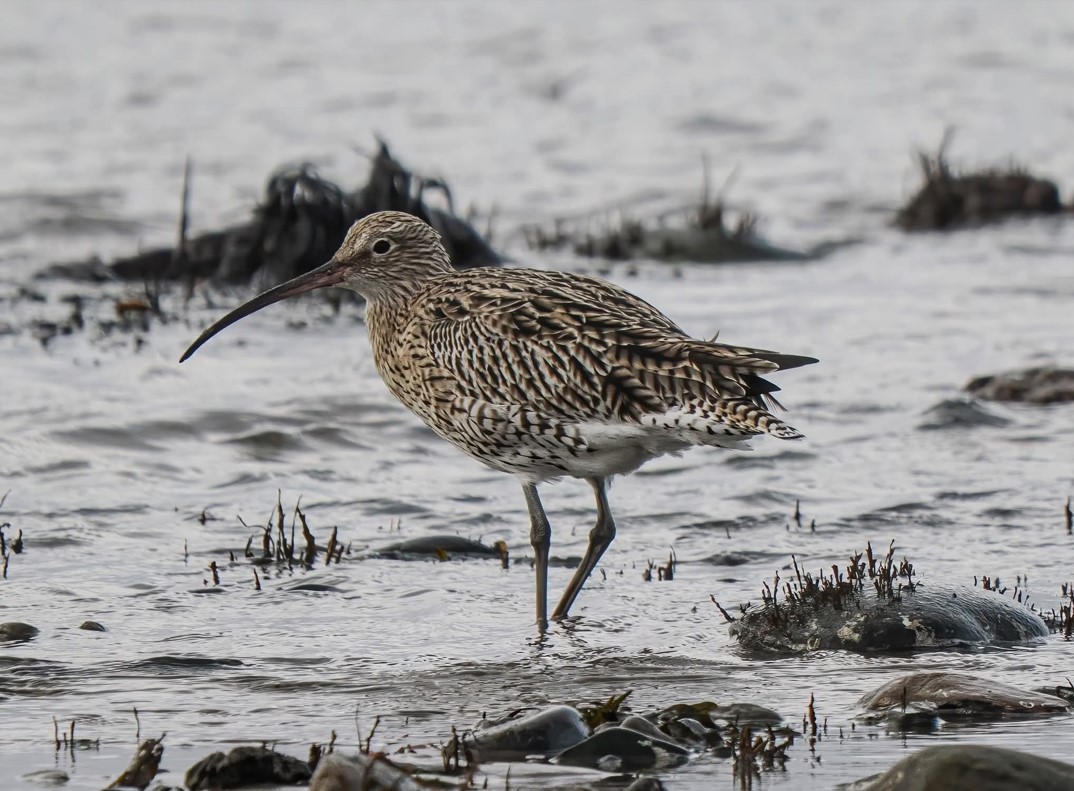
Photo credit: Tom Wilson
In October there were 81 records on iRecord for the Ayrshire Coastal Path.
Selected for Sighting of the Month is a common and familiar companion for those walking on the coast, especially at this time of year, the Curlew.
Being the largest European wader, and with it’s long downturned bill, long legs and loud, pure “Cour-lee”call it’s a species that is hard to miss. But Curlew are struggling, with the UK breeding population having dropped by over 50% in the last 25 years.
Known locally as the Whaup, changes in farming practices in lowland areas and increased forestry in our upland moorland settings have drastically reduced it’s breeding habitat. As a ground-nesting bird it is also vulnerable to predation, mainly by foxes. These pressures have led to the Curlew being added to the “Red List” of endangered species in the UK (highest level of concern).
On the coast Curlew numbers increase in autumn and winter, with UK breeding birds moving down from the uplands, to be joined by large numbers of birds coming here from Scandinavia.
Although the Curlew’s plumage is a light mottled brown, the bird will often appear dark when seen out on the shoreline at low tide, plodding sedately along probing for lugworms.
“SITE FIDELITY”
If you have a regular walk along the Coastal Path you may see a Curlew most times at the same spot and studies have shown that it is indeed likely to be the same bird you saw last week, last month, even last year! They are comparatively long-lived and are territorial, returning each year to defend their own wee patch on the coast, especially the females - noo there’s a thing!
At high-tide Curlews will congregate together at highwater roosts or in adjacent fields, where they will continue to feed in loose flocks e.g at Hunterston, Loans, Dipple and Ballantrae.
All shorebirds can be be easily disturbed by walkers at this time of year, so give them a wide berth. Remember, if you can’t support your local Sheriff, at least “Support Your Local Curlew”!
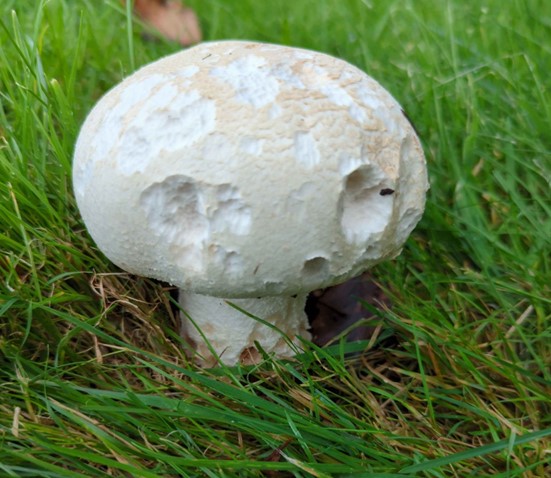
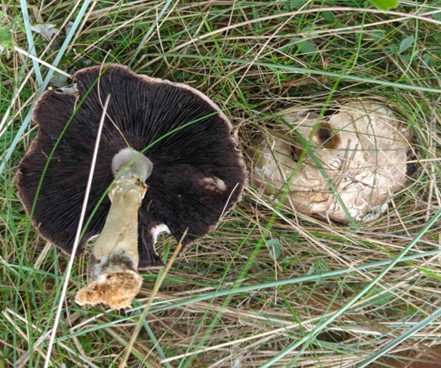
At this time of year mushrooms and toadstools seem to magically appear out of the ground and in August we had 6 records of these fungi on the Coastal Path iRecord page.
Pick of the bunch was an observation of Horse Mushroom by John Fergusson at Doonfoot towards the end of the month. Although this edible species is still fairly common, we probably see less of it nowadays due to loss of habitat (principally hedgerows and field edges).
Also, at various locations along the coast, Gill Smart recorded Shaggy Inkcap, Giant Funnel and Bracken Map. Unusual names to most of us, no doubt. In fact, it’s reckoned there are over three thousand species of larger fungi in the UK, all playing an important role in the health of the planet, by breaking down dead or decaying matter, recycling nutrients and helping restore fertile soils.
So how can we tell them apart? It’s a big advantage that they don’t move around and a field guide would often get us close to the correct name. If using photos, then a few steps would make ID more likely
> It’s important not to settle for just a photo of the cap on top. A clear view of the underside helps, either by taking a shot from the side, or as John has done to pick one or two specimens and take a photo upside down
> One can also take a specimen and cut it in half from top to bottom to show the internal features
> Some of the specimens might be at different stages of maturity and additional photos might show varying colours and textures
> Finally, if submitting via iRecord, a photograph of the immediate habitat might help an expert to narrow down the likely ID


Molluscs are a group of invertebrates which may be extremely common, but perhaps remain an under-appreciated part of our biodiversity.
They do a great job munching through decaying vegetation, snacking on algae or fungi and play an important role in recycling nutrients - benefitting other wildlife, and indirectly, us!
Many species in coastal habitats are known for their shells, which protect their squishy bodies e.g. mussels, periwinkles and snails. But of course in some molluscs, like slugs, the shell is small, internal, or even absent altogether.
The Brown-lipped Snail is the first mollusc chosen as our “Sighting of the Month”. Although common, it has an extraordinary variety of markings, from uniform yellow to very dark spiral bands. Looking at the aperture of snails can help with ID, and the diagnostic dark brown lip of this species was evident in the records submitted (by Lee Johnson at Greenan Castle and by Malcolm Haddow at Portencross).
There are around 100 species of land snails in the UK and 46 terrestrial slugs, so plenty to get your teeth into if you are interested.
If slugs and snails aren’t your thing, then perhaps it would be nice to see more of the large group of shoreline marine molluscs in the ACP records, e.g. Philip Budd spotted and recorded a Curled Octopus at Ayr beach at the beginning of last month. Well done Philip!
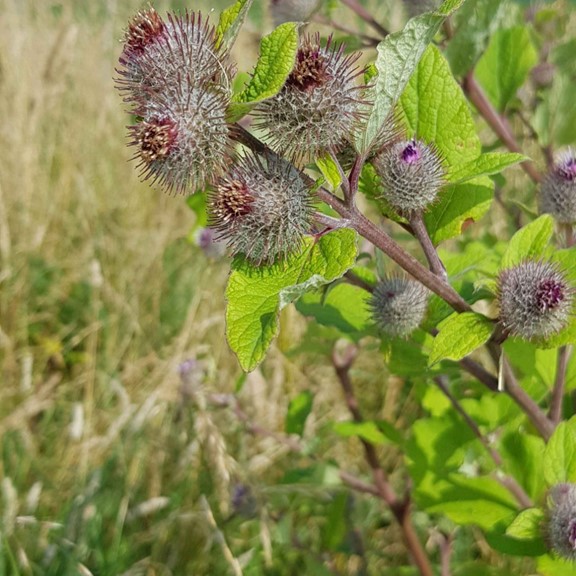
There were a healthy number of wildlife records (224) for the AyrshireCoastal Path iRecord activity in June. Many thanks to the 38 enthusiasts whosubmitted these.
Flowering plants were the largest species group, and so it seems appropriate to choose one of these for this month’s sighting - the modest, yet distinctive Lesser Burdock.
George de Mestral was a Swiss engineer, who apparently became interested in the Burdock group when he found the burrs from the top of plants stuck to his clothing and his dog Milka’s coat, when out walking in the Alps in 1941.
Under a microscope he found that thousands of miniscule hooks are responsible for this efficient method of dispersing seeds. He went on to develop and patent a touch fastener, based on tiny hooks, and commercially introduced this as “Velcro”in the late 1950’s.
Lesser Burdock is the species most likely to be seen in Scotland. Fully grown, it can still be a substantial plant, reaching up to 2m, with it’s thistle-like flowers attracting pollinators. A record was received from Drumshang, just south of Dunure last month, but in fact it is widespread across a variety of habitats, usually occurring as scattered individual plants.
(Thanks to Harry Burns and John Grace for background info).
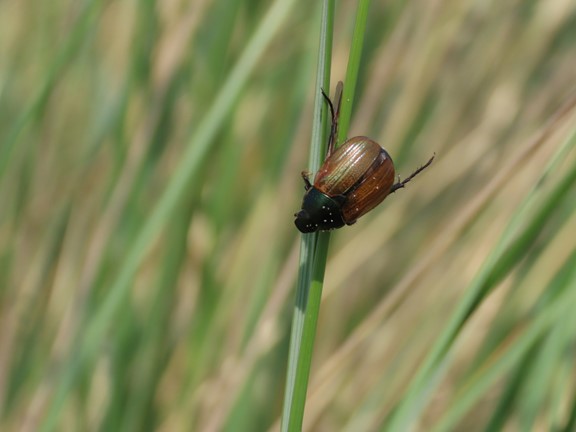
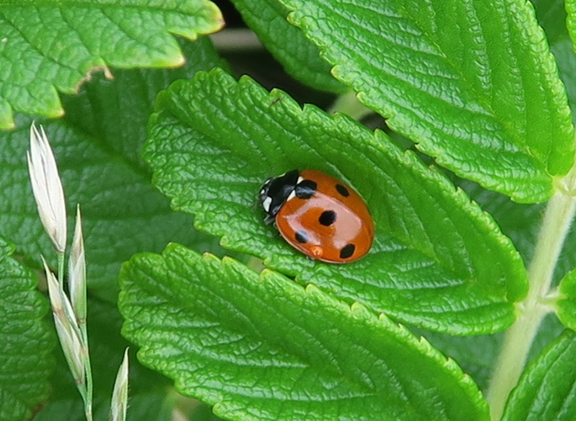
Lots more wee beasties at this time of year of course. While many of us perhaps ignore or try to avoid them, most are doing vital jobs for the health of the countryside, and some can also be amazing to look at, if we take the time to stop and examine them closely.
A great example, was the Dune Chafer, recorded by John Johnstonon on 21st June, just south of Irvine. As it’s name suggests, this uncommon, but quite large beetle tends to be found in sand dunes and at the top of beaches.
Great spot John!
It would be fantastic to see more small beastie records during the rest of the summer, including the more familiar Ladybird.
Did you know that there are 46 species of Ladybird in the UK. Not all are brightly coloured, and in SW Scotland the commonest species recorded recently were:-
> 7 spot Ladybird (photo above)
> Orange Ladybird
> 10 spot
> 2 spot (increasingly scarce)
So why not have a closer look next time you are out for a walk. Can you identify which one you are looking at. Taking a photo using iRecord will confirm.


This beautiful little butterfly, the Northern Brown Argus (NBA) was recorded four times around the middle of last month, all at separate locations, just north of Ballantrae.
Great spots, as there had only been a total of eight records (in the whole of Ayrshire) over the previous decade. Well done Derrin McGowan and Jackie Reid!
No doubt the good weather in April and early May helped many butterflies.
As well as the increased numbers we might all have noticed some arrived a lot earlier than usual, including the NBA. There are likely to be small colonies of this butterfly at sites along the Coastal Path, with south facing slopes providing the warmth and shelter it needs.
Another prerequisite is it’s caterpillar foodplant, Common Rock-rose. So, if you come across this pretty plant in June or July, it may be worth a close look at the leaves. Although the egg is less than a millimetre across, it can be remarkably easy to see, nearly always along the mid-rib on the upper surface of the leaf. Do let us know if you find any!
Many thanks to Derrin McGowan, who posted the photo of the butterfly on iRecord

Steve and Alison White were out walking in Irvine last Sunday. It was a dreich day, they hadn’t seen much, but thankfully decided to have one final look over the estuary mud of the River Garnock before heading home. They were surprised and delighted to spot a medium-sized wader they instantly recognised - an Avocet, a very rare visitor to Ayrshire.
The last confirmed sighting of this elegant bird in the county was way back in 1988, but fortunately this time it stayed in the area for a few days and was seen from several points on the Coastal Path.
Many of us will be familiar with the Avocet’s structure and plumage because of the fact that this species was chosen to be the emblem of the RSPB. With their long legs Avocets can wade deep into water and will sweep their upturned bills from side-to side as they feed.
They mainly take small crustaceans from brackish water in coastal lagoons. They are very much a social species, breeding in small colonies in SE England and forming flocks outside the breeding season, before migrating to SW England for the winter, with some flying on to Spain, Portugal or even Morocco.
They became extinct in the UK in the 19th century, primarily because extensive repairs of sea walls in East Anglia caused them to lose habitat. Conversely, humankind inadvertently helped them to recolonise when coastal marshes were deliberately flooded during the early part of World War 2. When Avocets first returned numbers were small, they needed protection and it was the heartening success of this that led to it’s adoption for the logo of RSPB.
The breeding population is now approaching 2000 pairs in the UK and although the bulk of these are still in SE England their range is slowly expanding, with occasional breeding as far afield as Wales and the Western Isles. Birds do pass through at this time of year as evidenced by more regular sightings in Dumfries and Galloway (on the Solway).
Many thanks to Steve and Alison for the photograph above. Their story illustrates that it’s always worth keeping your eyes peeled if you are out on the coastal path - even on a dreich day something might just pop up!


We are pleased to report that there was a substantial increase in records submitted last month - 73 records, with a healthy 59 separate species. Thanks to the 14 wildlife recorders who contributed!
With more records it’s trickier to choose a sighting of the month, but Stephen Bulloch’s photographs of a Yellowhammer pair from Dunure on 3rd March were outstanding and remind us that this beautiful bird is more likely to be seen at this time of year.
If you are in luck, you may see the male perched on top of a bush singing it’s heart out. With it’s bright yellow head, contrasting with a deep chestnut body, the male really stands out. The song is also unique, usually described as “A-little-bit-of-bread-and-no-cheese”, with special emphasis on the cheese!
The female is a more subtle version of the male, but still quite pretty.
Yellowhammers have been residents with us for a long time - the second part of it’s name has nothing to do with hammering, but comes from the word “ammer”, the Old German name for a bunting, the group of seed-eating birds Yellowhammers belong to.
Although a classic bird of the British countryside, Yellowhammers have had a tough time of it over the last few decades, with an estimated 64% decline since the mid-1960’s.
Many farmland bird species have suffered in a similar way, probably due to habitat loss and agricultural intensification. Loss of stubble has reduced it’s food in autumn and lower insect numbers means less food is available for it’s chicks in summer.
But some good news is that the Yellowhammer seems to be resilient and responds well whenever conservation efforts allow a more favourable environment, including cereal growing and crop diversity on farms, along with hedge restoration. Numbers in Scotland have been a bit more stable and there is no better place than the Coastal Path to see this wee beauty!
This could be a great month to be out on the Coastal Path- enjoy the birdsong along the way. If settled weather continues we might have a bumper spring for butterflies. And why not challenge yourself to see how many flowering plants you can record in April? It’s very easy to do using the iRecord app (see top of this page) or if you prefer just submit a photo to the us on the Facebook page.


Ducks featured well in our wildlife records for February, with Mallard, Goosander, Shelduck, Teal and Goldeneye all recorded along the Ayrshire Coastal Path.
The males of each of these species look smart at this time of year – this is the time to impress a lady duck, with a view to pairing up for the breeding season.
Male Goosanders have particularly striking plumage, with a glossy, green head, blood-red beak, black on the wings and back and a clean, white body, tinged a lovely salmon-pink – very dapper!
Female ducks always tend to be less flashy and the female Goosander is mostly grey, with a gingery-orange head.
Although predominantly a freshwater species, Goosanders will gather in river mouths and estuaries in winter and Lorna Thomas was the first to record one at Doonfoot on 4th February.
Interestingly, Goosanders weren’t historically a UK species. Burns won’t mention them! They first colonised in the late 19th century, successfully increased their distribution, and continue to maintain a healthy population.
Sadly, most of our February ducks will soon be on the move. Goosanders will head up river, usually nesting in tree cavities. Teal and Goldeneye will migrate further, mainly back to their breeding grounds in Iceland and Scandinavia.
But do keep an eye out along rivers through the season. The May morning photo above, from Margaret Howie on the River Doon, proves that all that duck dressing up and fancy courtship display can be worth it!
P.S. Spring is on the way – some nice birds will reach the Ayrshire Coast in March as they migrate northwards and others will be back soon to settle and breed. The frogs are croaking, butterflies will soon be on the wing and flowering plants will start to emerge again.
Why not try to keep your own record of when you first come across any of these friends this spring?
It’s very easy to do using the iRecord app or if you prefer just submit a photo to the us on the Facebook page.
%20DE%202025.jpg)
Everyone seems to love otters, but they can be elusive, tending to be more active at night, particularly in rivers or other waterways.
However, if you keep your eyes peeled, there is a reasonable chance you might be lucky enough to see one in daytime whilst walking the Coastal Path. The abundant food on the shore and intertidal zone encourages otters to be active during the shorter hours of daylight at this time of year.
There were records of sightings from William Hunter early in January (between Ballantrae and Lendalfoot) and from Gillian Craig on the 19 Irvine harbour. Well done both ofyou!
Most of us probably grew up in times when otters had become scarce in all parts of the UK, apart from the NW fringes of Scotland. They had suffered over many decades from persecution, but thankfully, legal protection, along with reduced use of agricultural pesticides and cleaner rivers allowed their numbers to recover.
On the Ayrshire Coast they can be seen at many locations, including the Hunterston area, Stevenston Point, Doonfoot and Maidens. Have you come across them anywhere else on the coast? A clue to the fact that otters are around is finding their droppings or “spraint”. These are left in conspicuous locations to indicate to other otters the boundaries of a territory. Fresh spraint is black and tarry, composed mainly of fish bones, and with a not unpleasant smell (described as reminiscent of Jasmine tea).
There are many species of otter around the world. Our Eurasian (or European) Otter has a wide range across Europe and Asia and is even present in some parts of Africa. All otters are part of the larger Mustelid group of mammals (which includes weasels, stoats and badgers). The only likely confusion species for us to consider in Ayrshire is a non-native member of that group, the American Mink.
Mink are much smaller, have a pointed nose and are usually very dark, almost black. If seen swimming, they are said to swim higher, with a greater part of the back visible. Their droppings are rather smelly…apparently! Mink tend to stick to rivers inland, but have been seen on the coast in the last few years, including at Pow Burn, Doonfoot and Maidens.
Since they escaped from fur farms in the 1950’s, they have had devastating impacts on populations of ground nesting birds, salmon and most of all, Water Voles. We’d therefore be very interested in receiving more records of Otter or Mink to have a better understanding of the distribution of both species along the Ayrshire Coast. You can submit a sighting on iRecord with or without a photo, but if you are able to include a photo, that would be simply fantastic!

Fewer sightings on the Coastal Path this month. The only mammal recorded was a Fox, although it was rumoured that some Reindeer may have been spotted over Ardrossan towards the end of December.
Therefore, for the second month in a row one of our avian winter visitors is the “Sighting of the Month”, this time the Turnstone.
This small, stocky member of the Sandpiper family will be familiar to many walkers, being fairly widespread along the Ayrshire coast. They have a short bill, with short orange legs. The upper parts are a lovely ,mottled, chestnut brown and black, with the underparts white.
A group of 18 were spotted at Greenan Shore, foraging amongst the seaweed on the water’s edge. Their other favoured place is on rocky shores, where typically they will be seen in small groups, constantly active, turning small rocks to catch insects or small crustaceans.
It is estimated that the UK wintering population is down by just over 20% over the last 25 years.
Their breeding grounds are in the Arctic tundra, with populations from Norway, Iceland, Greenland and Canada arriving on our shoresat overlapping intervals. Hence the species can actually be seen almost year - round, but with peak numbers from September through to March. In Spring, most will make the long return journey, the Canadians, as always, especially keen to be home in time for the end of season ice hockey playoffs


There were over 30 recorded sightings on the Coastal Paththis month. Thanks to all those who contributed.
For the first time the majority of records were of birds. Perhaps not surprising as whilst plants, butterflies etc. take a back seat at this time of year we are lucky to see an influx of avian visitors, especiallyon the coast.
Some of these are categorised as “passage migrants” – leaving northern latitudes to escape winter, but only stopping temporarilybefore heading further south to warmer climes.
A second group are true “winter visitors” staying with us locally or moving around yet remaining within the UK until spring.
This includes Whooper Swans which start to arrive from Iceland in October, often declaring themselves by their trumpeting calls in flight. Mark Turnbull skilfully photographed a group over Barassie beach on 2nd November and this is our “Sighting of the Month”.
Well done Mark!
Roughly the same size as the more familiar Mute Swan, Whoopers have a completely different profile, with a long straight neck (compared to the S shaped curve our resident swans). As truly wild swans they are shy and appear to be on constant look-out, usually holding their heads high and horizontal. With closer views the forehead continues straight onto the bill, which is yellow with a black tip.
More than 4000 Whoopers spend the winter in Scotland. Though most commonly seen in groups on lowland farmland or lochs/reservoirs, they can also be spotted on sheltered bays on the coast, occasionally along with MuteSwans.
Families make their migration together. Cygnets therefore learn from their parents – when to migrate, the best route and where feeding sites are along the way. They stay with their parents over the winter and start their journey back to their breeding grounds anytime from mid-March onwards. Other records this month included the small waders Dunlinand Turnstone, the elegant Greenshank and the reptilian Red-throated Diver.

